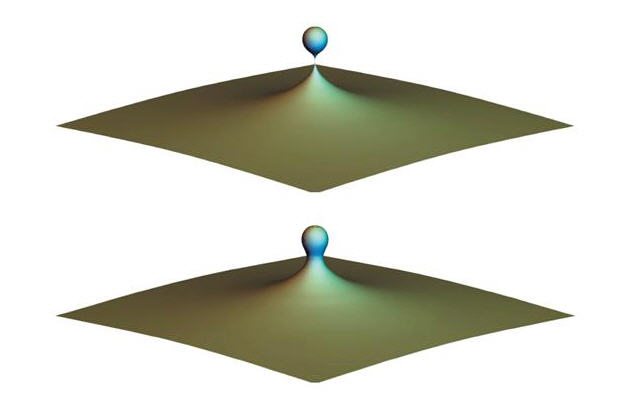How to merge two black holes in a simple way

The merger of two black holes, where one is so large that only a portion of it –nearly flat– is shown, while the other, smaller black hole falls into and is absorbed by the larger one. / Credit: Roberto Emparan & Marina Martínez
If we had to choose the most important and newsworthy piece of science news for 2016, the discovery of gravitational waves would have every chance of winning first prize.
The two signals that have been produced so far came from the collision and merger of two black holes in some remote part of the universe. The first detection was announced in February and the second in June, both by scientists from the Laser Interferometer Gravitational-Wave Observatory (LIGO) in the United States.
To determine the patterns of these waves and simulate how those mysterious fusions take place -a phenomenon characteristic of Einstein's general theory of relativity- scientists use the best supercomputers, such as the MareNostrum from Barcelona, Spain's most powerful supercomputer; however, there could be other, less complicated ways.
Physicists Roberto Emparan and Marina Martínez from the University of Barcelona have found a simple and exact way to approach the subject of the event horizon of two merging black holes, where one is much smaller than the other.
The joining together of horizons
The event horizon is the boundary that characterises a black hole; whereas the events inside the event horizon cannot affect an observer on the outside, the opposite can occur. When two black holes merge together, their event horizons join together to become one.
“Surprisingly, the ideas and techniques used in our work are elemental and allow us to thoroughly study the properties of the horizon at the moment both black holes join together to form one”, points out Emparan, who along with his colleague has published the results in the journal 'Classical and Quantum Gravity'.
The equations utilised to solve the problem are based on the physicists' basic knowledge, such as the definition of an event horizon and the so-called equivalence principle, which is part of the foundation of Einstein's theory of gravity.
According to this idea, an observer cannot tell the difference between free falling in a gravitational field and floating in deep space.
This is something we are familiar with because of pictures of astronauts on the International Space Station. Their noticeable weightlessness is not a result of their distance from Earth -gravity at the altitude of the station is 90% that of the gravity on Earth's surface- but is rather due to the fact that the orbiting station and the astronauts inside are freely moving through Earth's gravitational field.
A universal behaviour of two black holes that make contact
Likewise, in this study the small black hole that falls into a much larger one cannot tell this fall apart from another situation in which it is floating alone in space, thus allowing the description of the phenomenon to be greatly simplified.
Emparan and Martínez have utilised geometric elements in their study in order to describe the event horizon. Specifically, the horizon is obtained by plotting null geodesic lines on the so-called Schwarzschild metric, the solution to the field equations posed by Einstein for describing the gravitation field of a black hole.
According to the authors, these results make it easy to identify many geometric properties of the event horizon at the moment the two black holes join together. More importantly, “[the results] indicate the existence of a universal, general behaviour that occurs when two black holes come into contact with each other in any part of the universe”.
- Full bibliographic informationRoberto Emparan, Marina Martínez. “Exact Event Horizon of a Black Hole Merger”. Classical and Quantum Gravity 33. Number 15, 2016. DOI: 10.1088/0264-9381/33/15/155003
For further information, please contact:
Enrique Sacristan
Notes for editors
Para contactar con los investigadores:
Roberto Emparan and Marina Martínez. Universidad de Barcelona
Emails: emparan@ub.edu y marinamartinez@ub.edu
Tlf.: +34 934034818
Enrique Sacristán López
Redactor Agencia SINC
www.agenciasinc.es
Fundación Española para la Ciencia y la Tecnología
Edificio Museo Nacional de Ciencia y Tecnología
C/ Pintor Velázquez, 5 – 28100 Alcobendas (Madrid)
Tfno: 91 425 09 09 ext. 3251 – Fax: 91 571 21 72
Media Contact
All latest news from the category: Physics and Astronomy
This area deals with the fundamental laws and building blocks of nature and how they interact, the properties and the behavior of matter, and research into space and time and their structures.
innovations-report provides in-depth reports and articles on subjects such as astrophysics, laser technologies, nuclear, quantum, particle and solid-state physics, nanotechnologies, planetary research and findings (Mars, Venus) and developments related to the Hubble Telescope.
Newest articles

A ‘language’ for ML models to predict nanopore properties
A large number of 2D materials like graphene can have nanopores – small holes formed by missing atoms through which foreign substances can pass. The properties of these nanopores dictate many…

Clinically validated, wearable ultrasound patch
… for continuous blood pressure monitoring. A team of researchers at the University of California San Diego has developed a new and improved wearable ultrasound patch for continuous and noninvasive…

A new puzzle piece for string theory research
Dr. Ksenia Fedosova from the Cluster of Excellence Mathematics Münster, along with an international research team, has proven a conjecture in string theory that physicists had proposed regarding certain equations….



